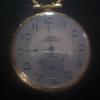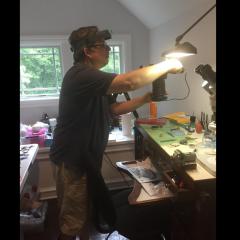Leaderboard
Popular Content
Showing content with the highest reputation on 07/20/16 in all areas
-
When fitting new stems to watches I use these tools :- Digital calipers, Fine grade diamond lap Wire cutter Pin vice Now for fitting. (1) Hold the stem in the pin vice and screw on the crown tightly by hand. (2) With the movement fitted correctly in the case, insert the stem until it locks in place. Now measure the gap between the case and the underside of the stem. In this case it is 2.16mm. (3) Subtract 0.2mm from this size and this will give the amount to remove from the stem. In this case it will be 1.96mm which will give 0.2mm clearance below the crown when fitted to the watch. (4) Now remove the crown from the stem and hold the stem very tightly in the pin vice, then place the pin vice and stem between the jaws of the digital calipers then zero the calipers. (5) Remove the calipers and without touching the zero button set them to minus 1.96mm. THEN RE-ZERO THE CALIPERS AT THIS LENGTH The wire cutters are now used cut off the excess thread leaving a small amount to be filed to the exact length. (6) All that is required now is to dress the stem with the diamond lap a little at a time until the calipers read zero. (7) Finally screw the crown on tightly and it should be ready to fit to the watch without further adjustment. I find that this method cuts down on trial and error. FOR SCREW DOWN CROWNS. A) Screw down the crown tightly onto the case without the stem and measure the distance nbetween the bottom of the crown and the case. B ) Screw the new stem tightly into the crown, then insert into the watch until it engages and locks into the movement. C) Press the crown down firmly as far as it will go and hold it there. D) Using the vernier callipers, measure the distance between the bottom of the crown and the case. E) Subtract the size determined in (D) from the size measured in (A) then subtract a further 0.15mm from this size. This is the amount to shorten the stem by. This should allow the crown to screw full home without compressing the stem too tightly between the movement and the inside of the crown. F) Cut the stem leaving it slightly longer than the size determined in (E), and dress down to size using the diamond lap and vernier callipers as described in the original post. G) Screw the crown onto the shortened stem and check fit and function, before using a tiny spot of Loctite 221 to secure. Click here to view the article1 point
-
The key point here is that this watch is not yours; it belongs to a friend. I recommend you not attempt any repair unless you give him an explicit disclaimer that there is a high risk that you will leave the watch in worse condition that it is now. Only if he accepts that should you proceed. If his considered options are your amateur repair versus discarding the watch, he may ask you to do the attempt. If he has any emotional or financial investment in the watch, he should not. In fact, if you discern that he has either of those, you should decline the invitation to repair the watch, since he and you may both come to regret an attempt even if he has accepted your disclaimer. --Eric1 point
-
The Canon pinion isn't stuck it's just that you don't grasp what you're trying to do. It's not a conventional Canon pinion at least conventional for a modern watch. So older pocket watches many times do not have what we perceive to be a Canon pinion. The Canon pinion itself is driven on to a center shaft that goes through a hollow tube of the center wheel. In the case of yours we can see the center pins sticking up. Then a course you can look on the other side and see the square part. Others like the image I attached of a watch I'm doing doesn't stick up beyond the top of the Canon pinion. Then just because you don't have the square doesn't mean it's one of these can and pinions as an example I have. Then recently I saw one that was rounded on the other side making it look just like the conventional pivot of the center wheel only a little crack revealed that it was a separate pin then of course there's the visual difference of the Canon pinion they look different. So staking set is ideal bench block with care and a hammer. You need to put the square part with its washer into an opening into a bench block or a staking set hole so it can fall out. But you definitely have to support the plate around it. Then flat punch on the protruding part carefully tap it should just fall out..1 point
-
1 point
-
1 point
-
1 point
-
If there is no case seam visible its probably a front loader so will have a split stem give the winder a pull and see if pops out. You'll then need a glass compression tool to remove the glass the watch movement then comes out off the front.1 point
-
1 point
-
I don't think that there is an easy answer to your question. It comes down to a combination of what you want to achieve, your skill level, your imagination, determination, ingenuity, etc. One school of thought says that a good idea is to start with a watchmakers turns rather than a lathe. They are cheaper, simpler, slower (which means more control and fewer accidents), and because you are turning between centres, very precise. On the other hand a lathe is quicker and requires a little less patience, but with the risk that if things go wrong they do so very quickly. As far as cost goes there are bargains to be had. I managed to pick up a BTM 8mm lathe, and a Lorch 6mm lathe for £60 for the pair. There was just 1 collet in each lathe, and both machines looked rough. The bearings however were good, and the beds true, so all that was required was a bit of elbow grease to clean them up and set them up with motors (salvaged from old sewing machines). Then careful watching eBay and I have managed to gradually acquire collects and build up a useful set up. Alternatively take a look at posts by fellow forum members #szbalogh who has put together a setup based on a Dremel. His efforts are (to me) inspirational and just go to show what can be achieved with a bit of ingenuity and determination. How much you use a lathe I think will depend on the sort of watches (or clocks) that interest you. I find that with wrist watches the most the lathe is used for is grinding rivets to remove broken staffs from balances. I have yet to make a staff for a wrist watch as I managed to acquire a useful stock of staffs in a job lot of stuff. Older (particularly pocket) watches where parts are just notavailable will give you more opportunity to hone your skills. My lathes don't get a lot of use at the moment but I wouldn't be without them. As with any skill practice makes perfect so the more you use your lathe the better you will become. Like I said, no easy answer.1 point
-
you could send it to india. they do this on every dial. just kidding. in my humble opinion, if you absolutely have to have the indices on that dial, than you might have to send it to a restorer. other than attempting to paint them on yourself. those might be the only options left. - or - third option - keep your eye out for a replacement dial. if you find one, you could use your existing dial as a test subject to repaint.1 point
-
You could get the balance in beat in another way, but be warned that if you are not experienced working inside the movement you are at extreme risk of doing some very serious damage. The escapement is one of the most delicate parts of the watch. Having said that, to get the watch in beat: 1. Remove the balance 2. Properly let the power out of the mainspring. Do this by gripping the winder, using a tweezer hold the click away from the ratchet wheel and SLOWLY let the power down by allowing the winder to spin in a controlled manner. 3. Remove the pallets 4. Place the balance back in the watch and see if you can get a visual on the location of the roller jewel on the bottom of the balance assembly. 5. Use the #2 lever (the stud arm) adjustment to get that roller jewel dead centered in between the banking pins when at rest PLEASE do not attempt this if you are unclear about any of these steps. I'd suggest trying this out on a junk movement first - although many watches do not have a movable stud arm (you set the beat by actually rotating the hairspring collet on the balance staff) Best of luck!1 point
-
I'm In a similar position to you Folkvisor. Very well said and I think it's true of everything we use in life,. What works for you is good, never mind the fancy yellow label syndrome.1 point
-
I think a 4x Optivisor is fabulous for most pocket watches. Also, I have an astigmatism so, being able to wear glasses under the Optivisor is a huge help. I also use a 10x/18x loupe that attaches to the temple of my glasses. My feeling is you should use whatever works best for you.1 point
-
1 point









